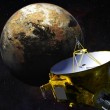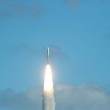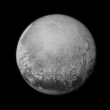NASA has made another historical attempt when they gathered new HD images of Pluto during it’s first flyby early Tuesday
NASA’s New Horizons spacecraft liftoff was at 2 p.m. EST on January 19, 2006, traveling about 58,000 kilometers per hour set on a mission to Pluto. Aboard an Atlas V rocket after nine years of travel, NASA astronauts and Johns Hopkins University Applied Physics Laboratory/Southwest Research Institute has released new close-up HD images of a region near Pluto’s equator.
Images reveal a range of mountains that rise as high as 11,000 feet (3,500 meters) above the surface of the icy planet’s body. These mountains are assumed to be 100 million years old. Jeff Moore of New Horizons’ Geology, Geophysics and Imaging Team stated,
This is one of the youngest surfaces we’ve ever seen in the solar system.”
Pluto cannot be heated by gravitational interactions so some other process must be generating the mountainous landscape. Methane and nitrogen ice covers much of the surface of Pluto and these chemicals are not strong enough to build the mountains. According to NASA, a stiffer material, most likely water-ice, created the peaks.
The closest image was taken about 1.5 hours before New Horizons closest approach to Pluto, when the craft was 47,800 miles (77,000 kilometers) from the surface of the planet. The HD image resolves structures smaller than a mile across.
-Infinite Wiz(@InfiniteWiz)




